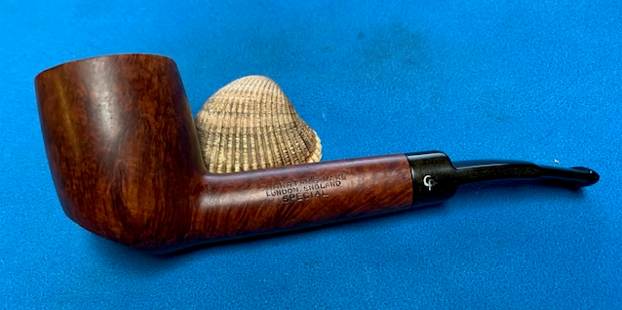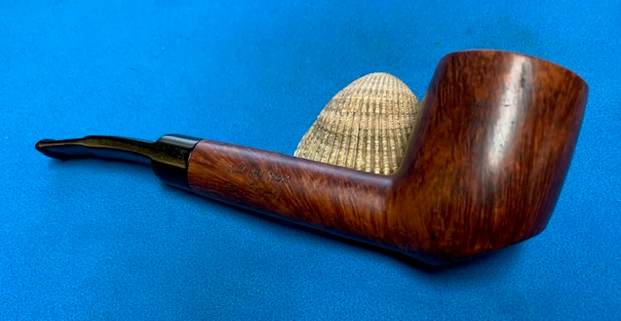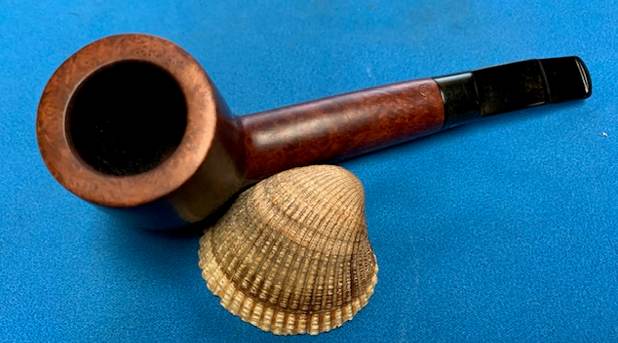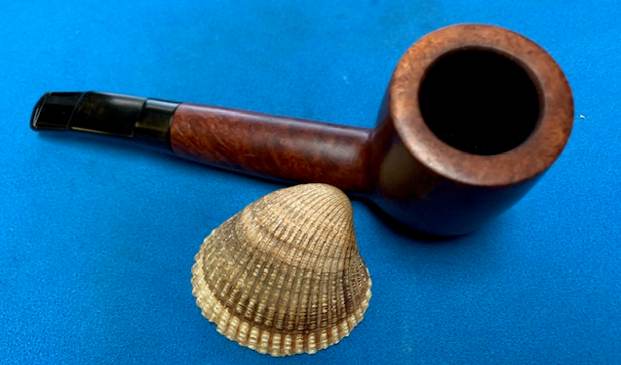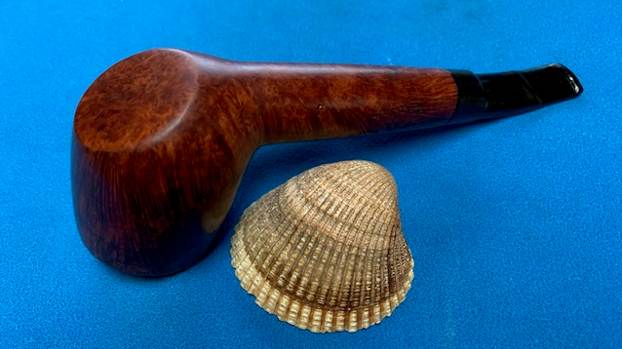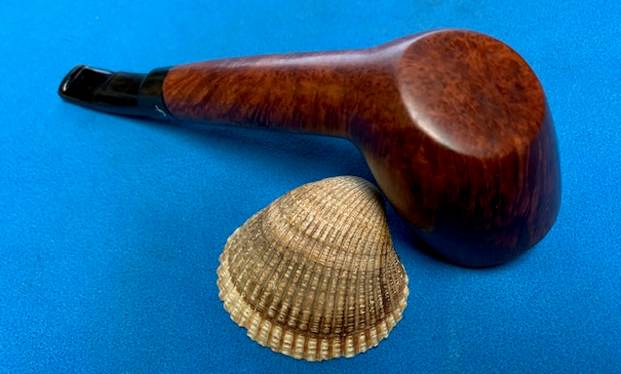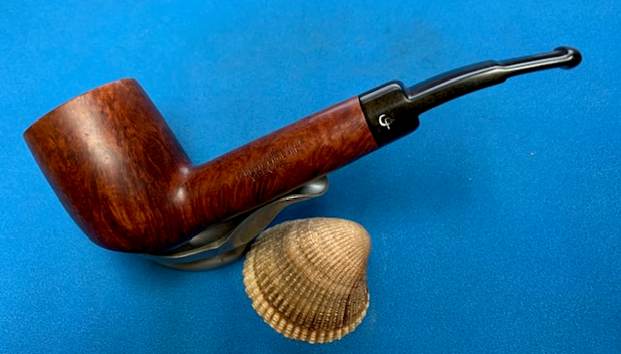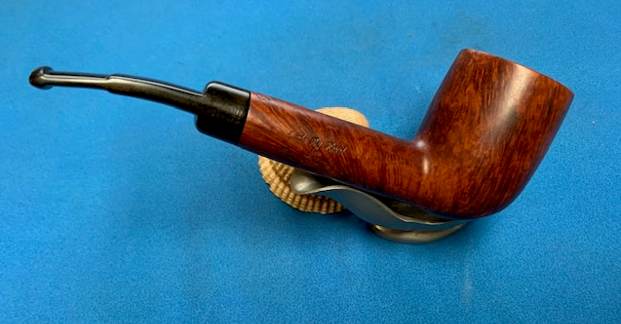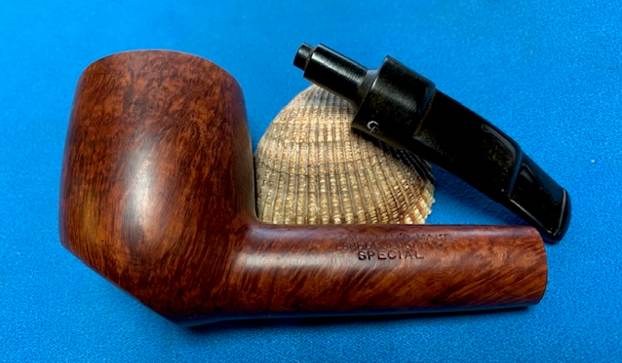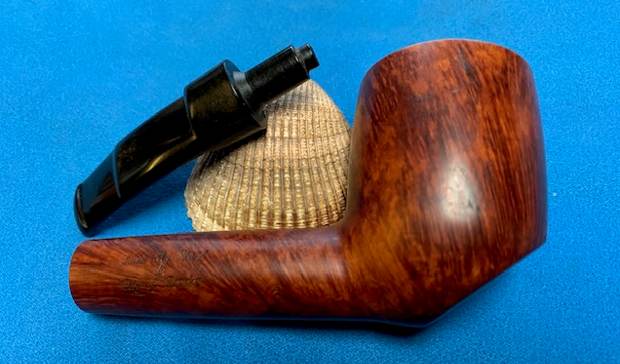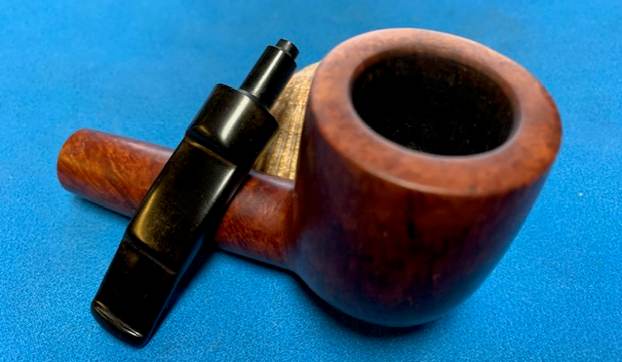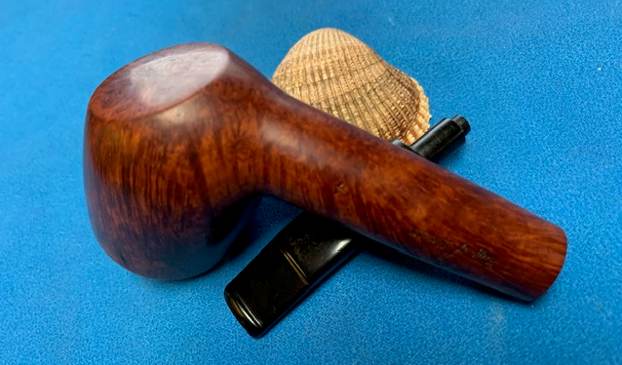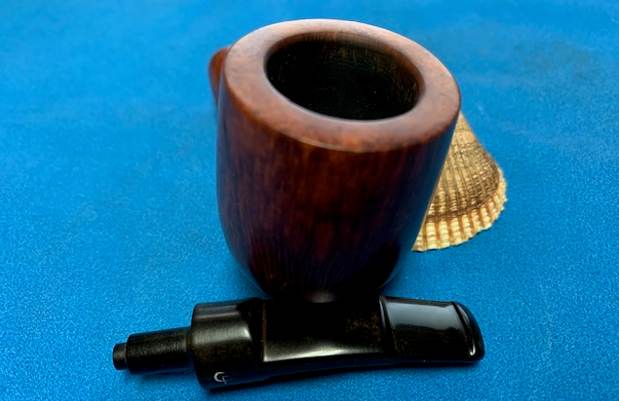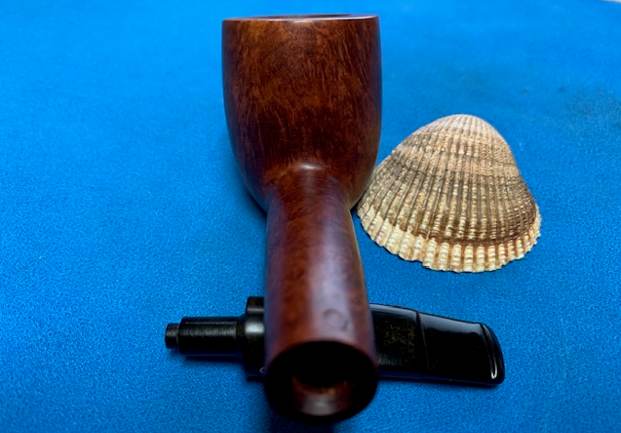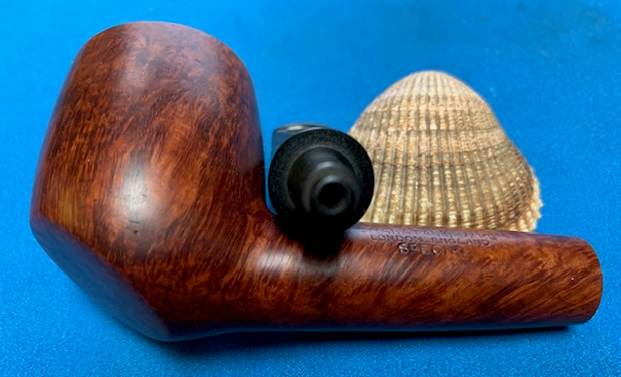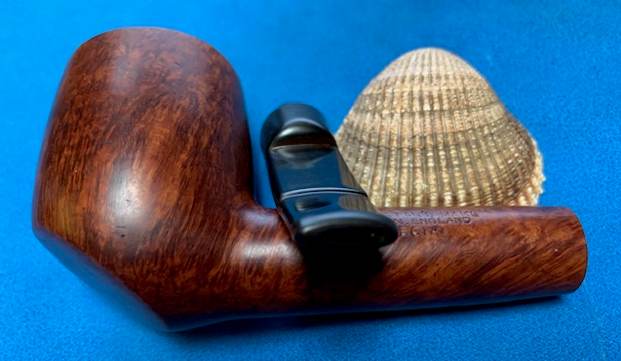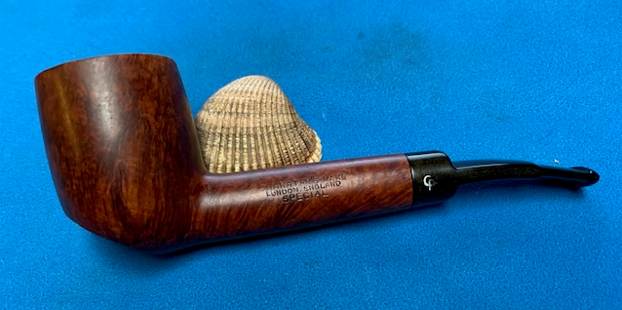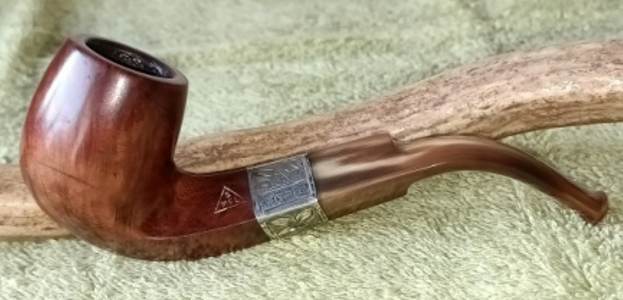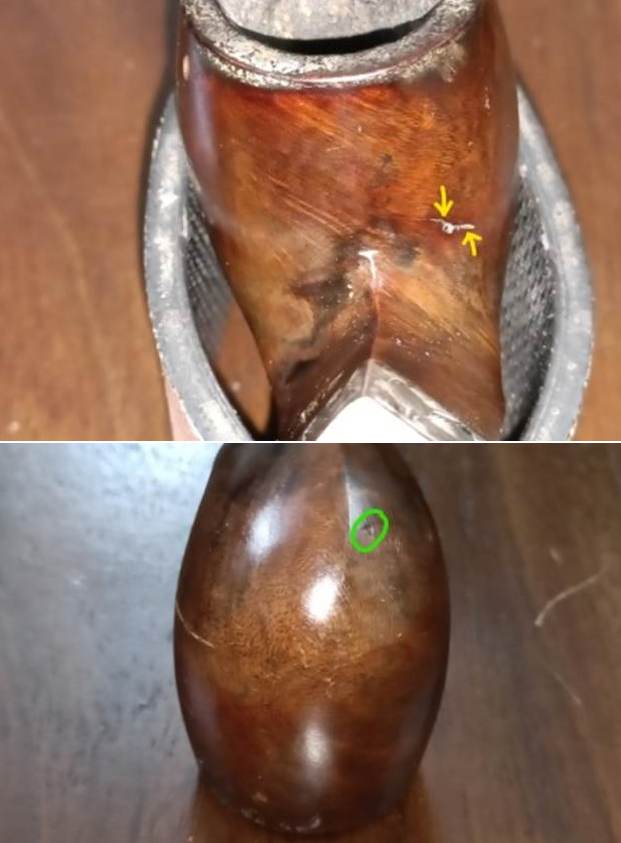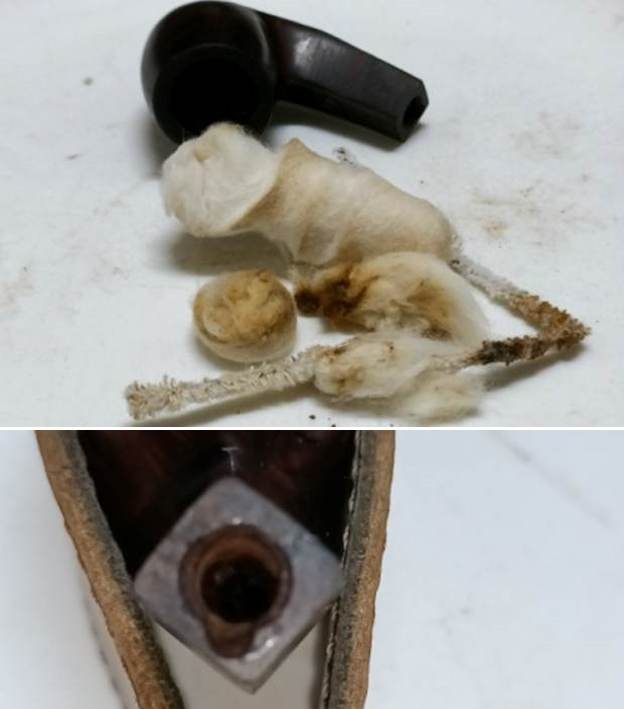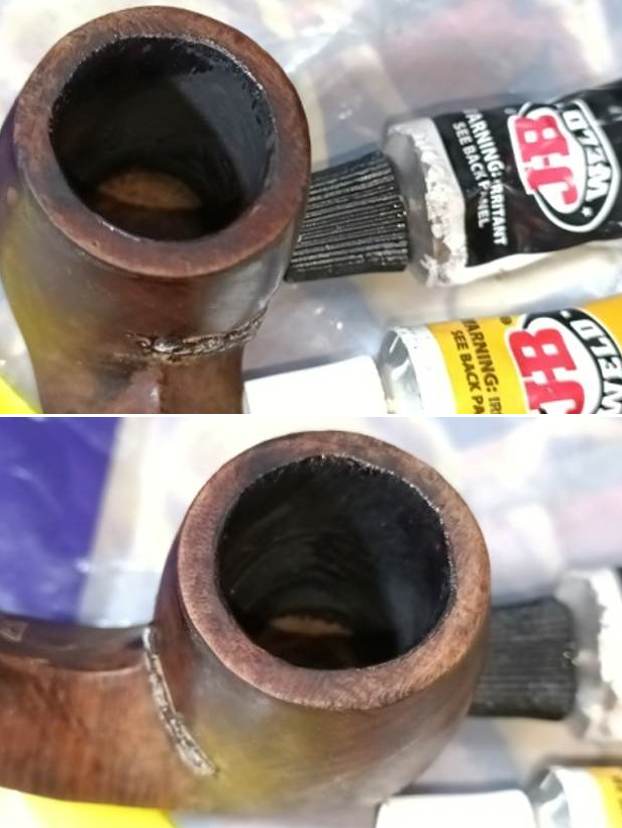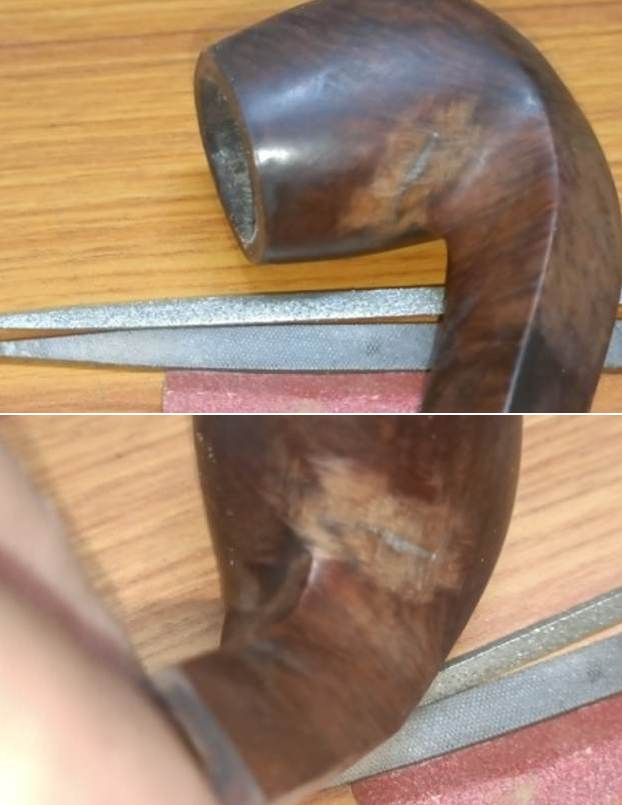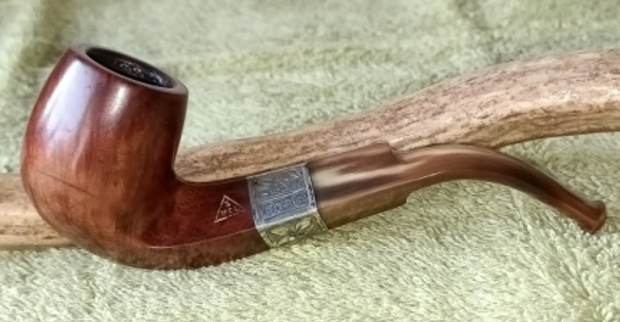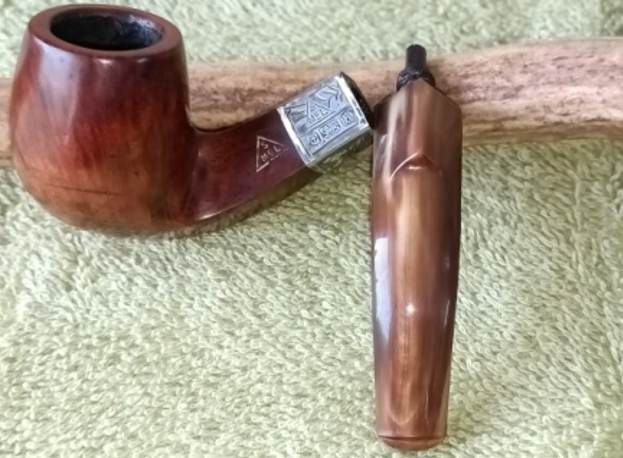Blog by Steve Laug
The next pipe I have chosen to work on is a nice looking straight grain Billiard with the front heel flattened making it a sitter. It has a smooth rim top and a double comfort saddle stem. We picked it up on 04/09/2022 from a seller in Cleveland, Ohio, USA. The stamping on the left side of the shank read Charatan’s Make [over] London, England [over] Special. On the right side it is stamped Made By Hand [over] in [over] City of London. That is followed by the number 4 stamped next to the bowl shank junction. On the topside of the shank at the shank/stem junction is a cursive L in a circle identifying it as a Lane Pipe. The black vulcanite saddle stem is a Charatan’s Lane Era Double Comfort Stem with a CP stamped on the left side of the saddle. The pipe is a nice looking pipe with a reddish brown finish that highlights the grain on the bowl sides and shank. It is light weight and comfortable pipe to hold. Jeff sent me the following photos of the pipe to show the condition it was in before he worked on it.
This is what I saw when I looked over the pipe.
- The finish is dull with hand oils on the sides and some thick grime ground into finish around the bowl sides. The stain is dull and the grain patterns though visible under the grime are obscured around the bowl sides and shank
- The rim top was very dirty with darkening and a heavy lava coat on it. It is heavier on the back side. The inner edge of the bowl is hard to see under the thick build up of cake that has overflown the bowl top.
- There was a thick cake in the bowl. The bowl itself was very dark and dirty. Once the bowl was cleaned up we could confirm the condition of the bowl walls.
- The vulcanite stem was filthy, oxidized, calcified and had tooth marks and chatter on both sides. There were some deeper tooth marks on the underside ahead of the button.
- There is a Charatan CP logo stamped on the left side of the shank. It is faint but still readable.
To summarize what I saw – this Charatan’s Make London, England Special Sitter, Made by Hand in City of London is a well made pipe. The bowl and stem are very dirty which says to me that the pipe was someone’s favourite pipe. The look and feel of the pipe in the hand is great. It should clean up very well. Here are photos of the pipe taken before Jeff started the clean up. 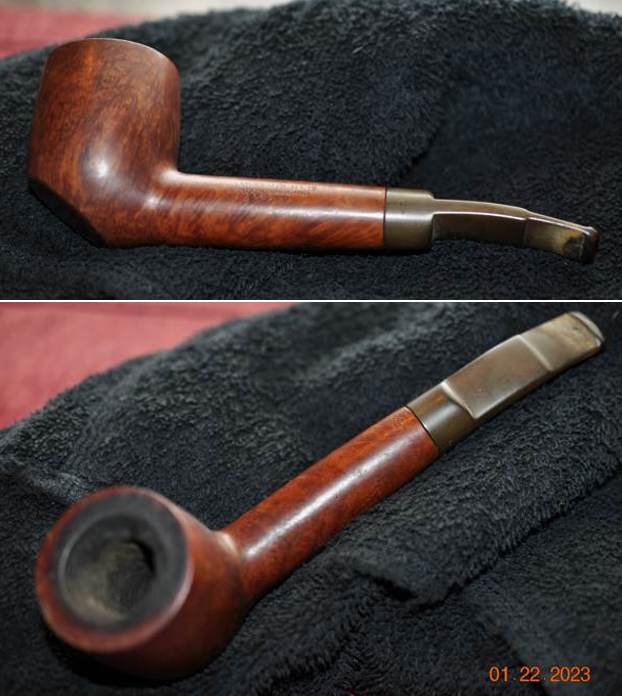
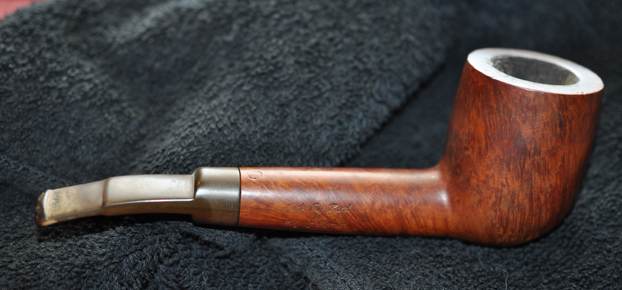 Jeff took close up photos so that I could have a clearer picture of the condition of the bowl, rim edges and top. The rim top photos confirm my assessment above. The cake in the bowl is thick – covering the walls of the bowl. The rim top has thick lava coat overflowing and covering the inner edge. It is heavier toward the back of the bowl. It is hard to know the condition of the inner edge in this condition. This is what I look for when assessing a pipe. I look forward to viewing it in person after the clean up work.
Jeff took close up photos so that I could have a clearer picture of the condition of the bowl, rim edges and top. The rim top photos confirm my assessment above. The cake in the bowl is thick – covering the walls of the bowl. The rim top has thick lava coat overflowing and covering the inner edge. It is heavier toward the back of the bowl. It is hard to know the condition of the inner edge in this condition. This is what I look for when assessing a pipe. I look forward to viewing it in person after the clean up work.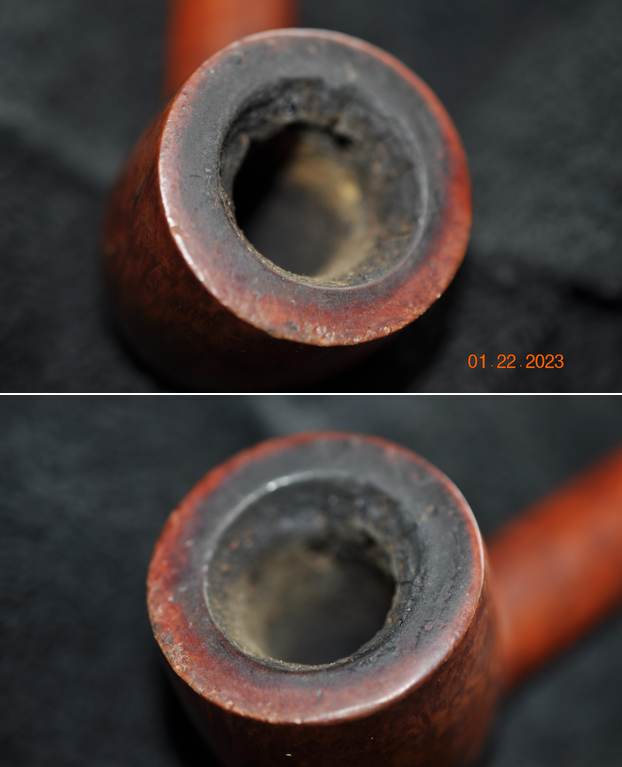 The Double Comfort vulcanite saddle stem is dirty, oxidized and calcified. There are tooth marks and chatter on both sides ahead of the button. The marks on the underside are deeper than on the topside.
The Double Comfort vulcanite saddle stem is dirty, oxidized and calcified. There are tooth marks and chatter on both sides ahead of the button. The marks on the underside are deeper than on the topside.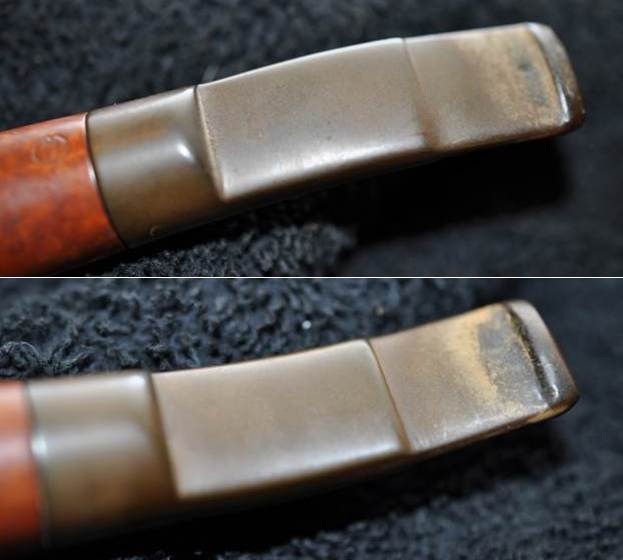
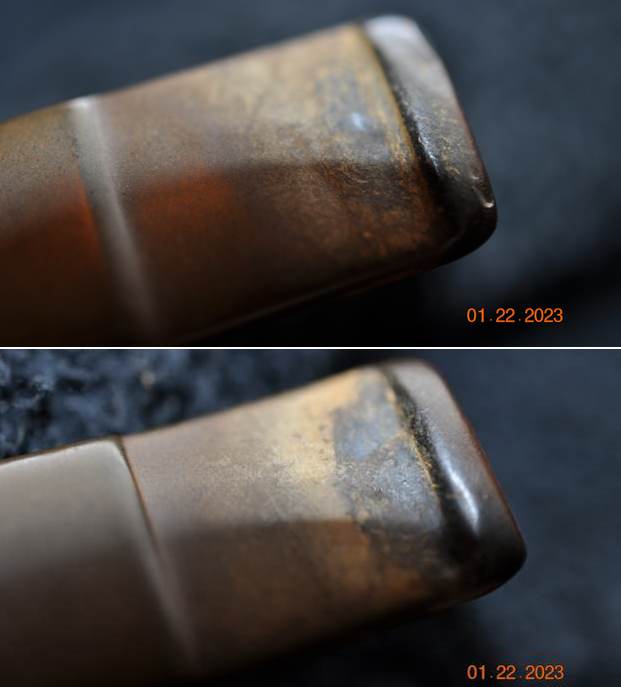 Instead of telling you what I see in the next photos of the sides of the bowl and the heel I want to hear from you. Tell me what you see? What does the finish look like to you? Are there any visible problems or issues that stand out to you? Are there cracks or scratches in smooth finish of the bowl? Are there visible flaws or fissures in the briar? What does the finish look like? Is there a pattern to it? Any visible issues on the heel of the bowl? These questions should help you to see what I am looking for when I see these photos.
Instead of telling you what I see in the next photos of the sides of the bowl and the heel I want to hear from you. Tell me what you see? What does the finish look like to you? Are there any visible problems or issues that stand out to you? Are there cracks or scratches in smooth finish of the bowl? Are there visible flaws or fissures in the briar? What does the finish look like? Is there a pattern to it? Any visible issues on the heel of the bowl? These questions should help you to see what I am looking for when I see these photos. 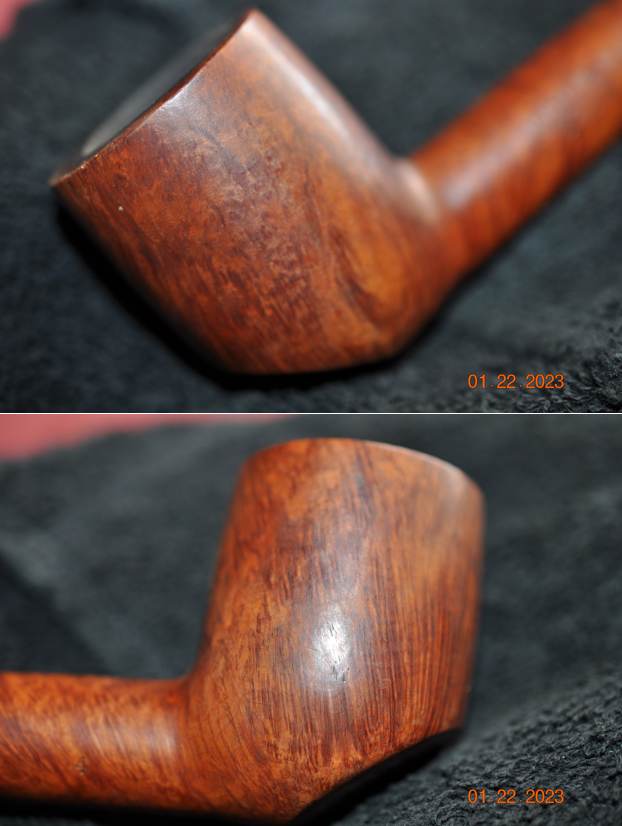
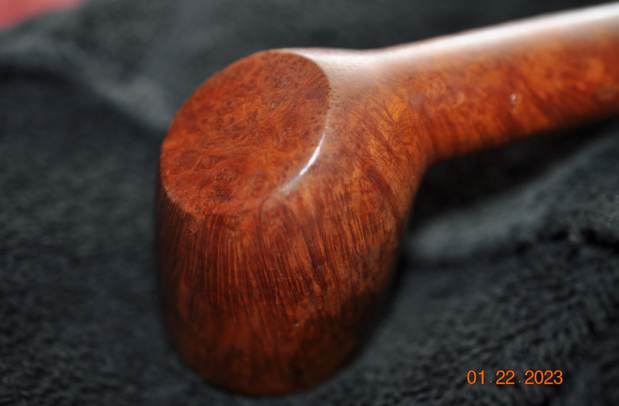 He took photos of the stamping on the sides of the shank. It is stamped as noted above on the right and the left sides. The vulcanite stem shows a CP stamp on the left side of the saddle. What stands out for you in the photos of the stamping? What do you look for in the stamping? It is dirty but what do you see underneath the grime on the surface of the briar?
He took photos of the stamping on the sides of the shank. It is stamped as noted above on the right and the left sides. The vulcanite stem shows a CP stamp on the left side of the saddle. What stands out for you in the photos of the stamping? What do you look for in the stamping? It is dirty but what do you see underneath the grime on the surface of the briar?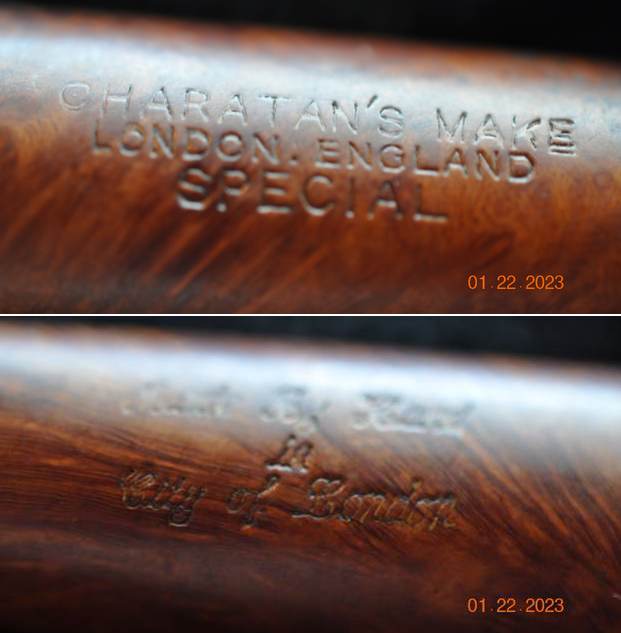
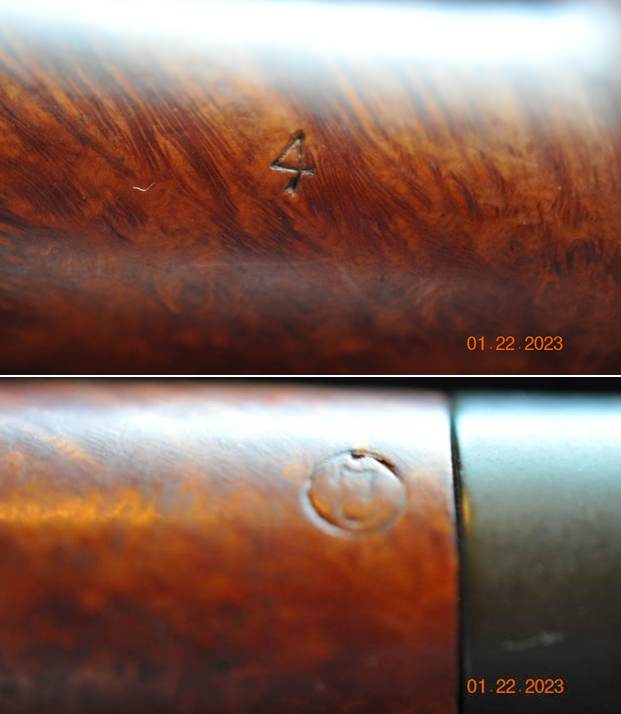 I turned to Pipephil’s site (http://pipephil.eu/logos/en/logo-charatan.html) to look up information on the Special line. There was a listing there but there was no photo in the listing. I have included the screen capture below.
I turned to Pipephil’s site (http://pipephil.eu/logos/en/logo-charatan.html) to look up information on the Special line. There was a listing there but there was no photo in the listing. I have included the screen capture below. I am sure many of you will shake your head and ask maybe even out loud, “Why is he including this again?” However, please remember that the point of these blogs is not to wow your with the work or make you shake your heads but I want you to know the details of the work we do so you can do your own. Back in 2020 Jeff wrote a blog about his cleaning process. I am including a link to that now so you can see what I mean about his process. Do not skip it! Give it a read (https://rebornpipes.com/2020/01/20/got-a-filthy-estate-pipe-that-you-need-to-clean/). Here is the introduction to that blog and it is very true even to this day.
I am sure many of you will shake your head and ask maybe even out loud, “Why is he including this again?” However, please remember that the point of these blogs is not to wow your with the work or make you shake your heads but I want you to know the details of the work we do so you can do your own. Back in 2020 Jeff wrote a blog about his cleaning process. I am including a link to that now so you can see what I mean about his process. Do not skip it! Give it a read (https://rebornpipes.com/2020/01/20/got-a-filthy-estate-pipe-that-you-need-to-clean/). Here is the introduction to that blog and it is very true even to this day.
Several have asked about Jeff’s cleaning regimen as I generally summarize it in the blogs that I post rather than give a detailed procedure. I have had the question asked enough that I asked Jeff to put together this blog so that you can get a clear picture of the process he uses. Like everything else in our hobby, people have different methods they swear by. Some may question the method and that is fine. But it works very well for us and has for many years. Some of his steps may surprise you but I know that when I get the pipes from him for my part of the restoration they are impeccably clean and sanitized. I have come to appreciate the thoroughness of the process he has developed because I really like working on clean pipe!
For the benefit of some of you who may be unfamiliar with some of the products he uses I have included photos of three of the items that Jeff mentions in his list. This will make it easier for recognition. These three are definitely North American Products so you will need to find suitable replacements or order these directly on Amazon. The makeup pads are fairly universal as we were able to pick some up in India when we were with Paresh and his family.
In the blog itself he breaks his process down into two parts – cleaning the stem and cleaning the bowl. Each one has a large number of steps that he methodically does every time. I know because I have watched him do the work and I have seen the pipes after his work on them. He followed this process step by step and when the pipe got to me it was spotlessly clean and ready for my work. The inside of the stem, shank and bowl were clean and to me that is an amazing gift as it means that my work on this end is with a clean pipe! I cannot tell you how much difference that makes for my work.
- The finish is clean and the oils and grime in the finish shows the beautiful straight grain around the sides. The medium brown stain highlights the grain.
- The rim top was clean but there were still damage on the top and the inner edge of the bowl. It is clean and with a little work will look very good.
- There cake in the bowl has been removed and the bowl is very clean. The walls of the bowl are smooth and appear to be undamaged and show no checking or burn damage.
- The vulcanite saddle stem looks better though the tooth marks and chatter on both sides are visible. There were some deeper tooth marks on the underside ahead of the button.
- The Charatan CP logo stamped on the left side of the stem looks very clean but is faint and readable.
Hopefully the steps above show you both what I look for when I go over the pipe when I bring it to the work table and also what I see when I look at the pipe in my hands. They also clearly spell out a restoration plan in short form. My work is clear and addressing it will be the next steps. I took photos of the whole pipe to give you a picture of what I see when I have it on the table. This is important to me in that it also shows that there was no damage done during the clean up work or the transit of the pipe from Idaho to here in Vancouver. 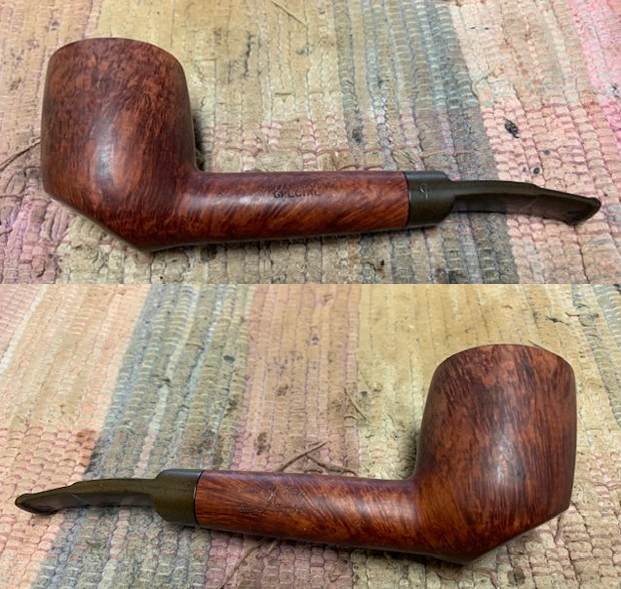
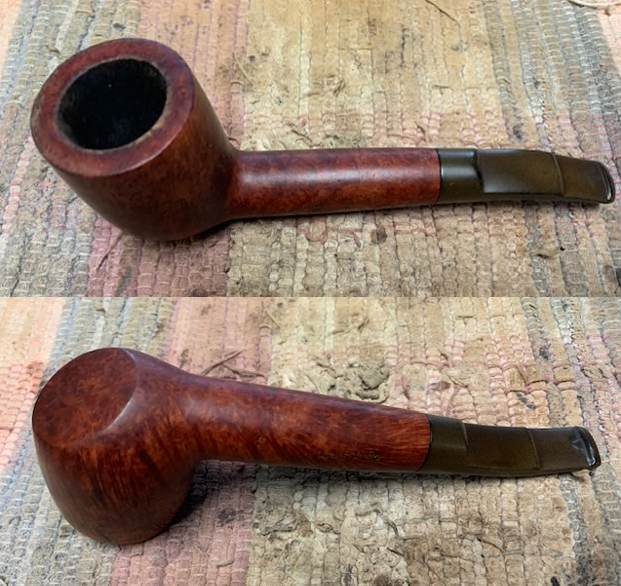 I carefully went over the bowl and rim top to get a sense of what is happening there. In this case once the rim top and edges were cleaned the rim top looked better. The inner edge was in good condition and looked good with the rusticated plateau style rim top. I also went over the stem carefully. The fit of the replacement to the shank is snug and the transitions are smooth. There were some tooth marks and chatter on the surface of the stem and the button on the underside. The acrylic stem surface was clean and looked better. I took photos of the rim top and stem sides to show as best as I can what I see when I look at them.
I carefully went over the bowl and rim top to get a sense of what is happening there. In this case once the rim top and edges were cleaned the rim top looked better. The inner edge was in good condition and looked good with the rusticated plateau style rim top. I also went over the stem carefully. The fit of the replacement to the shank is snug and the transitions are smooth. There were some tooth marks and chatter on the surface of the stem and the button on the underside. The acrylic stem surface was clean and looked better. I took photos of the rim top and stem sides to show as best as I can what I see when I look at them. 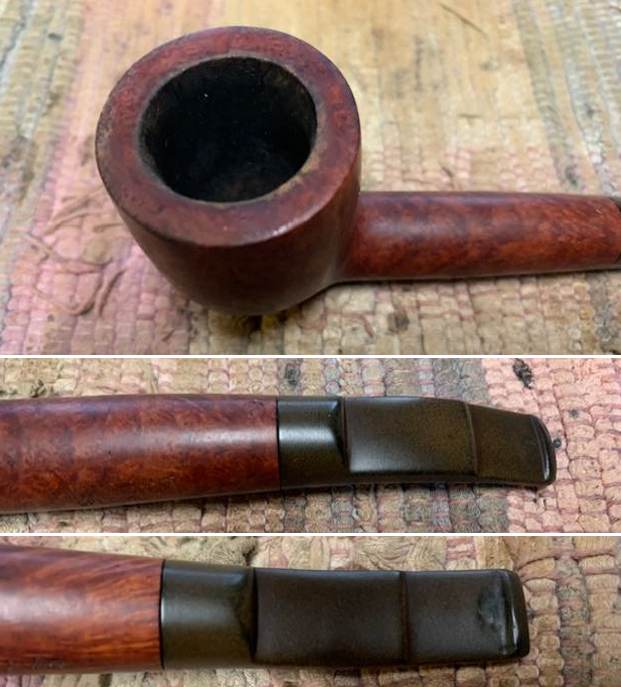 I always check to make sure that the clean up work did not damage the stamping on the shank sides in any way. It is in excellent condition and is very clear and readable. I love just looking at the lay of the pipe and the proportion of the hand made pipes. I took the pipe apart to get a sense of what was in the mind of the pipe maker when he crafted the pipe. The photo shows its beauty in flow and shape.
I always check to make sure that the clean up work did not damage the stamping on the shank sides in any way. It is in excellent condition and is very clear and readable. I love just looking at the lay of the pipe and the proportion of the hand made pipes. I took the pipe apart to get a sense of what was in the mind of the pipe maker when he crafted the pipe. The photo shows its beauty in flow and shape.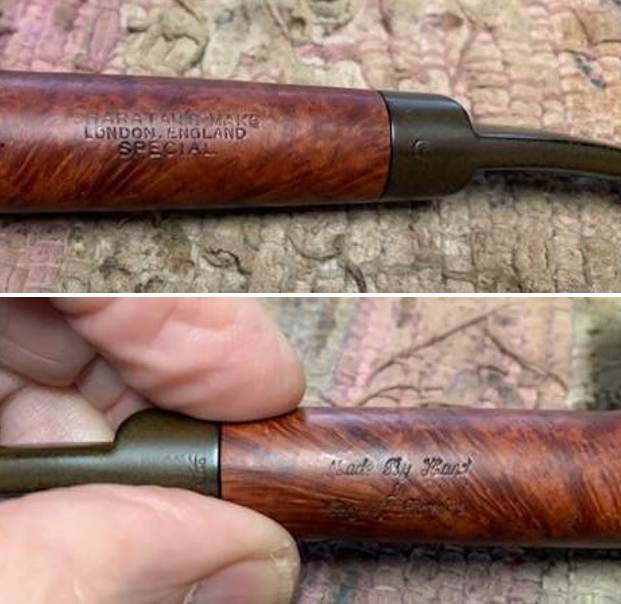
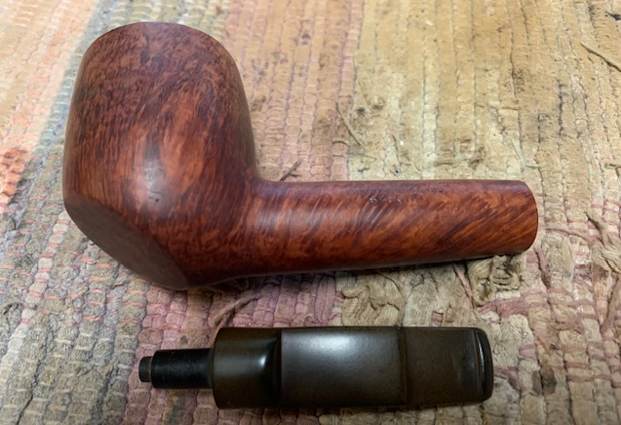 I started working on this pipe by turning to the bowl. I chose to deal with the darkening on the inner edge and top of the rim. I used a piece of 220 grit sandpaper to remove the darkening on the inner edge and the damage on the top. It took a little work but I was able to remove most of the damage. It looks much better after I worked it over.
I started working on this pipe by turning to the bowl. I chose to deal with the darkening on the inner edge and top of the rim. I used a piece of 220 grit sandpaper to remove the darkening on the inner edge and the damage on the top. It took a little work but I was able to remove most of the damage. It looks much better after I worked it over. I polished the briar with micromesh sanding pads. I choose to dry sand the briar rather than wet sand it. Again it is a matter of personal preference. I prefer to use the pads dry and find they work very well on the briar. I sand with each pad (9 in total) and group them by threes for ease of reference. I wipe the bowl down after each pad with a damp cloth to remove the sanding debris and check the briar. I love seeing the developing shine on the briar as I move through the pads which is why I include so many photos of this step.
I polished the briar with micromesh sanding pads. I choose to dry sand the briar rather than wet sand it. Again it is a matter of personal preference. I prefer to use the pads dry and find they work very well on the briar. I sand with each pad (9 in total) and group them by threes for ease of reference. I wipe the bowl down after each pad with a damp cloth to remove the sanding debris and check the briar. I love seeing the developing shine on the briar as I move through the pads which is why I include so many photos of this step.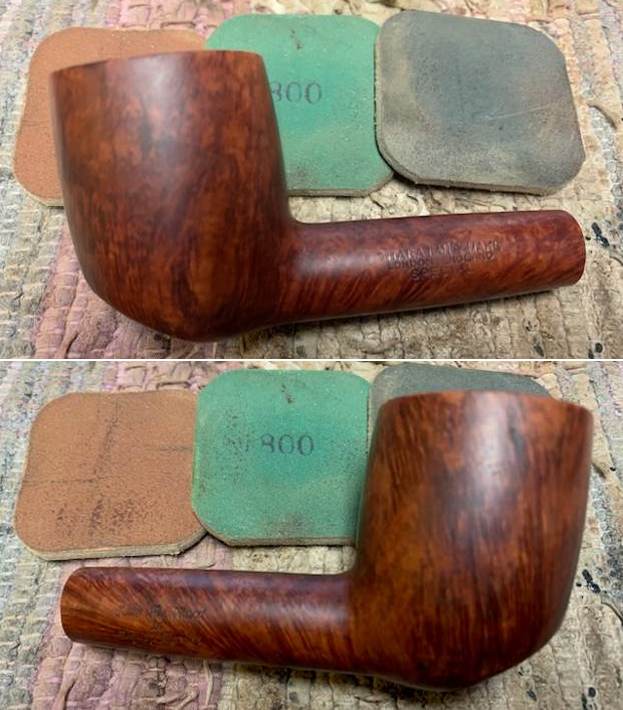
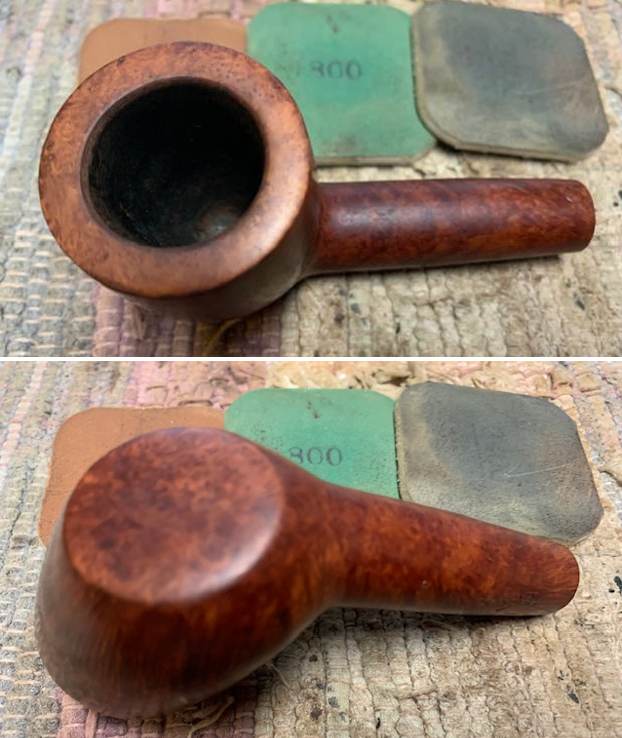
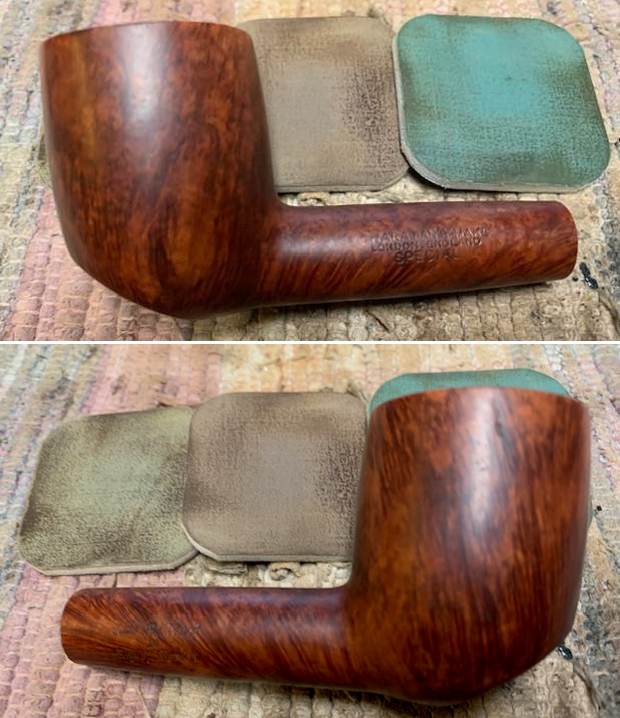
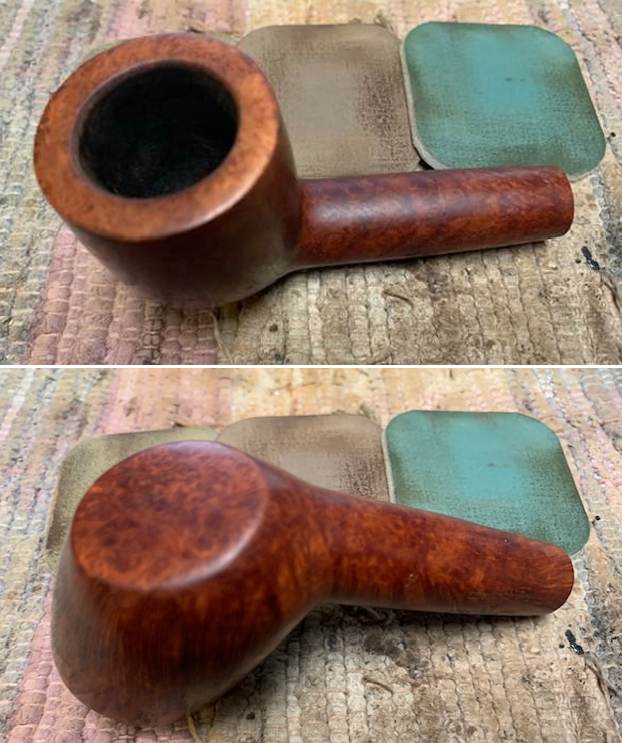
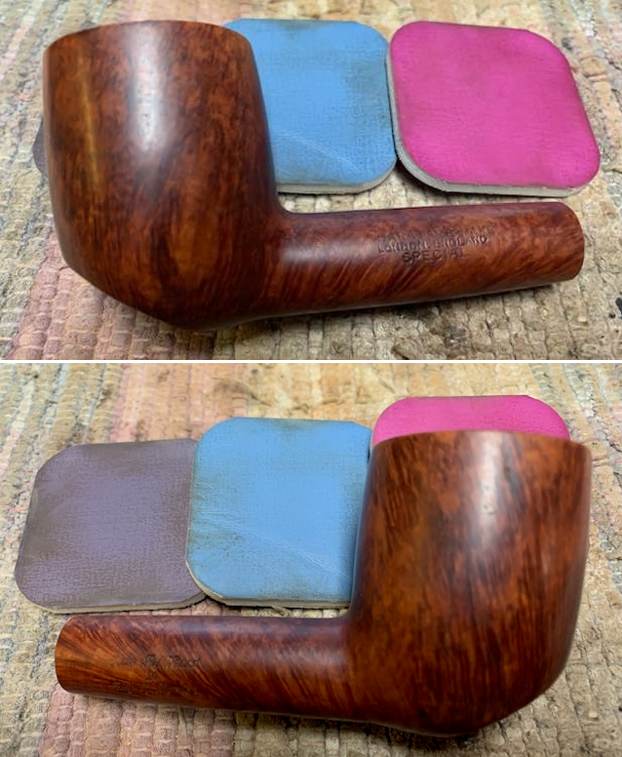
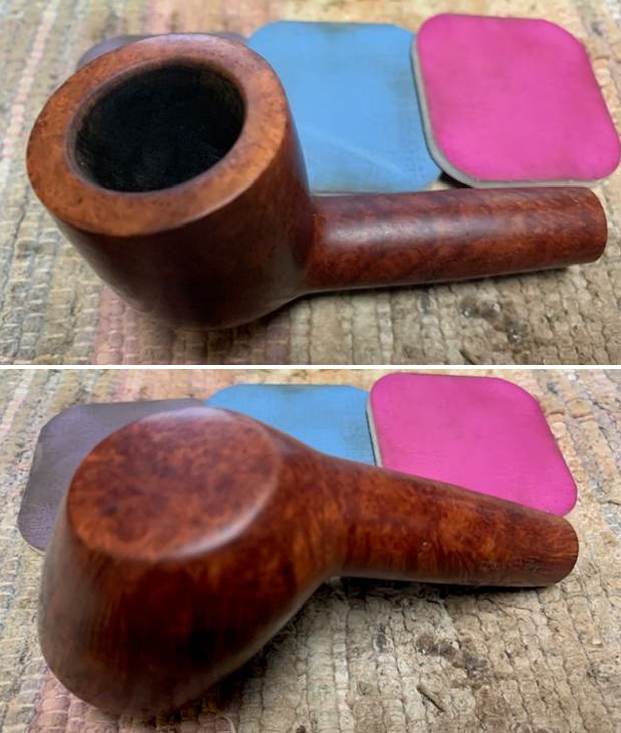 I rubbed down the bowl and shank with Before & After Restoration Balm. It is a paste/balm that is rubbed into the surface of the briar. The product works to deep clean the finish, enliven and protect the briar. I worked it into the briar with my finger tips. I let it sit for 10 minutes then wiped it off with a soft cloth then buffed it with a cotton cloth. The briar really began to have a deep shine in the briar and the rustication showed depth. The photos I took of the bowl at this point mark the progress in the restoration. It is a gorgeous pipe.
I rubbed down the bowl and shank with Before & After Restoration Balm. It is a paste/balm that is rubbed into the surface of the briar. The product works to deep clean the finish, enliven and protect the briar. I worked it into the briar with my finger tips. I let it sit for 10 minutes then wiped it off with a soft cloth then buffed it with a cotton cloth. The briar really began to have a deep shine in the briar and the rustication showed depth. The photos I took of the bowl at this point mark the progress in the restoration. It is a gorgeous pipe. 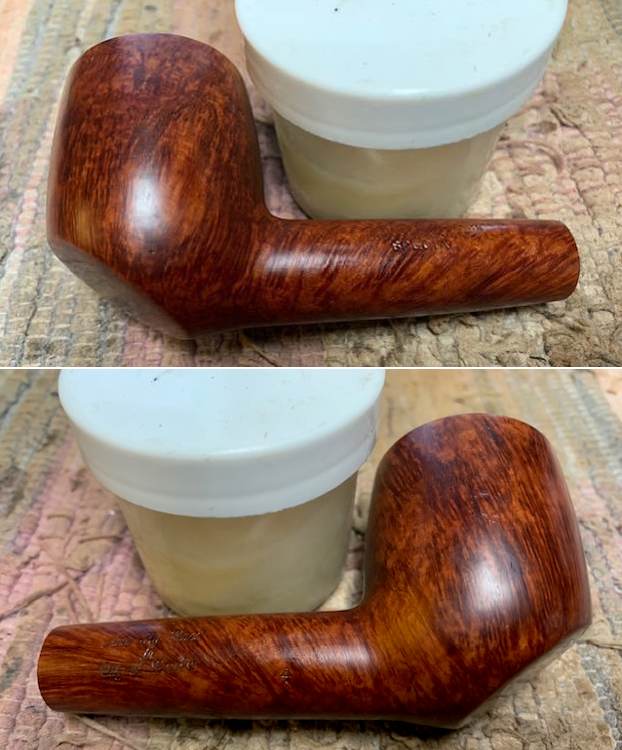
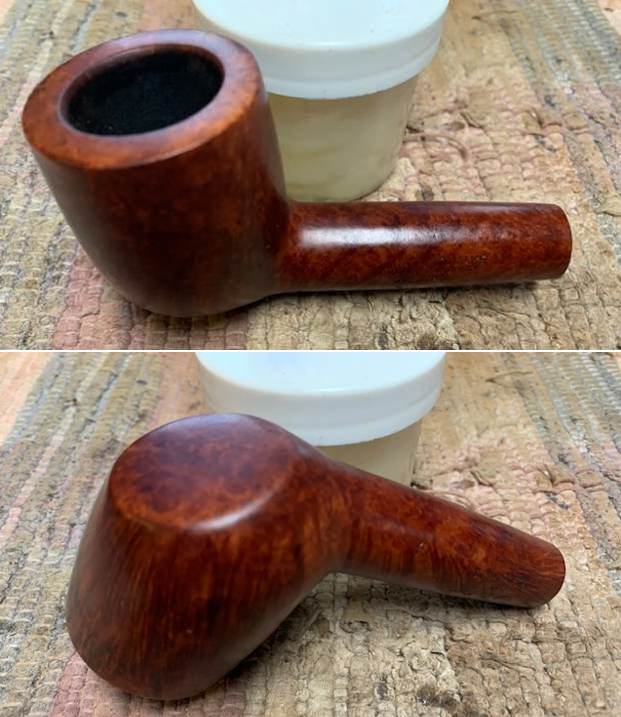
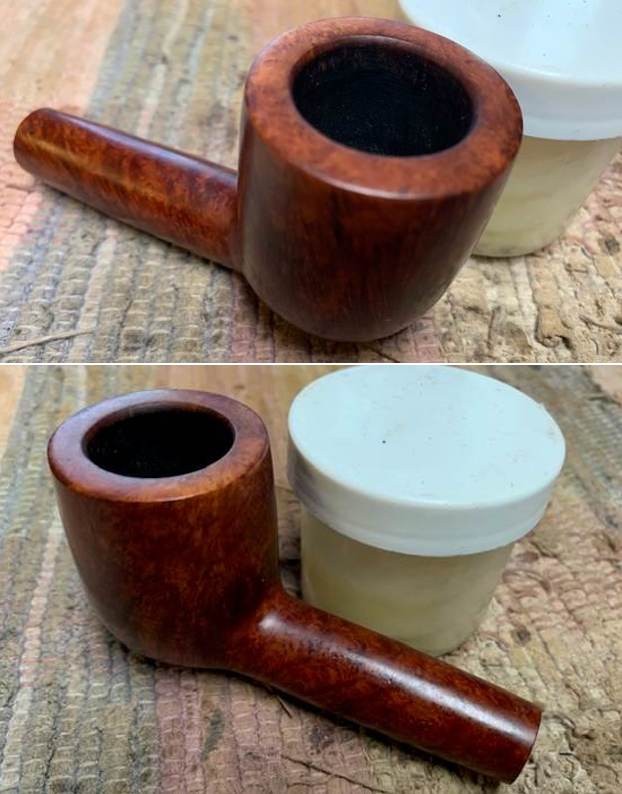 I set the bowl aside and turned to the stem. I “painted” the stem surface with the flame of a Bic lighter to lift the tooth marks. I was able to lift them some. While they were better they were still there. I filled in what remained with black rubberized CA glue. I used a small file to flatten out the repairs and start to blend them into the surface of the vulcanite. I finished my work on the repairs by sanding them smooth with 220 grit sandpaper. I started the polishing of the stem with 600 grit wet dry sandpaper.
I set the bowl aside and turned to the stem. I “painted” the stem surface with the flame of a Bic lighter to lift the tooth marks. I was able to lift them some. While they were better they were still there. I filled in what remained with black rubberized CA glue. I used a small file to flatten out the repairs and start to blend them into the surface of the vulcanite. I finished my work on the repairs by sanding them smooth with 220 grit sandpaper. I started the polishing of the stem with 600 grit wet dry sandpaper.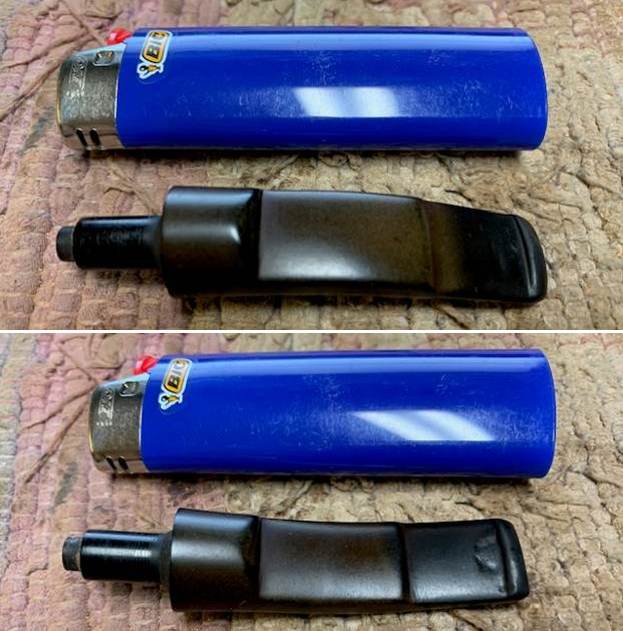
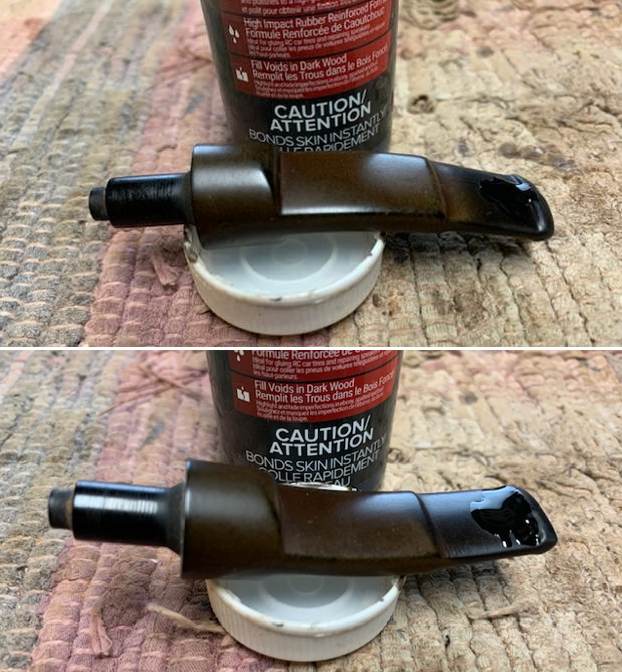
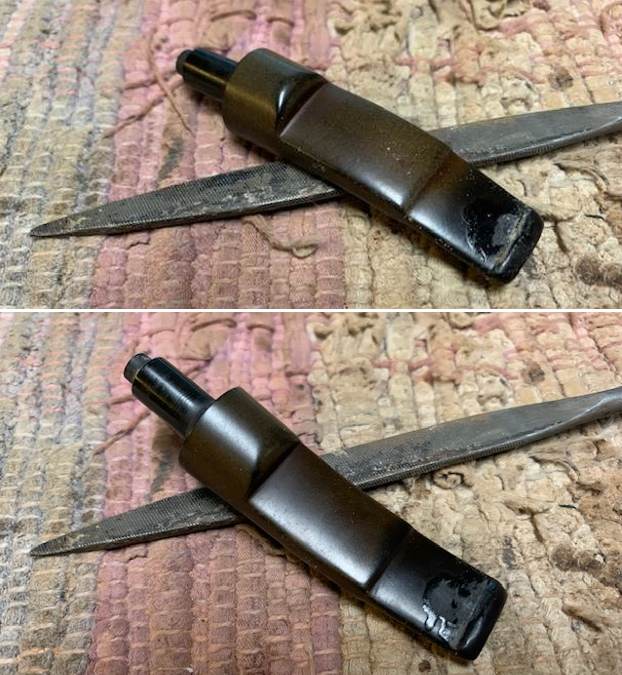
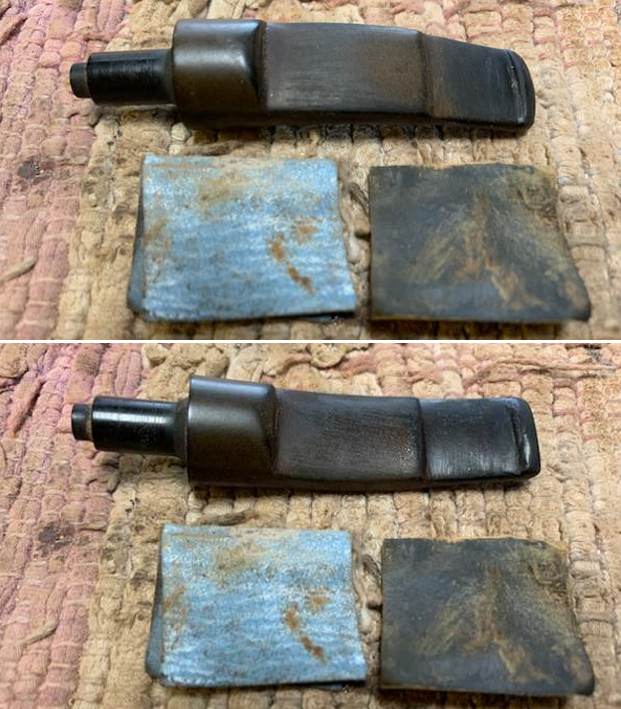 I wiped the stem down with Soft Scrub cleanser to remove the remaining oxidation on the stem surface. It looked much better.
I wiped the stem down with Soft Scrub cleanser to remove the remaining oxidation on the stem surface. It looked much better. 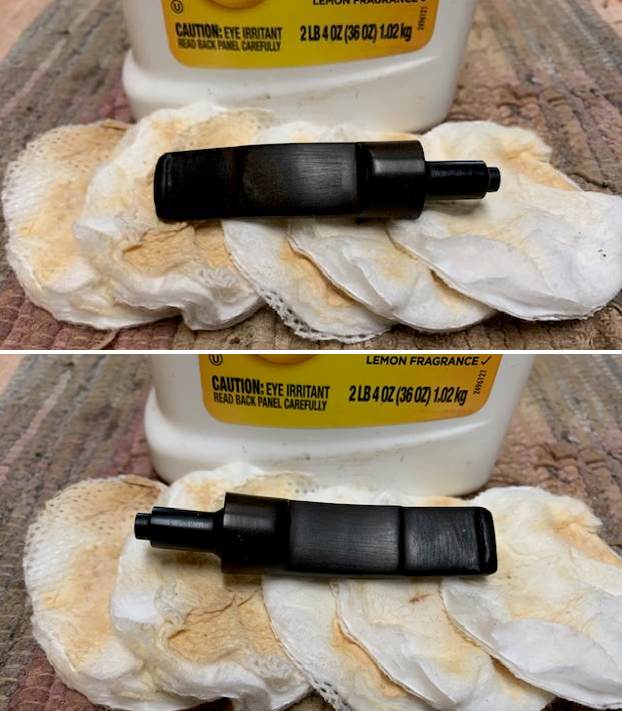 I touched up the faint CP stamping on the left side of the stem. The logo is readable though the P is missing the curve of the right side of the P.
I touched up the faint CP stamping on the left side of the stem. The logo is readable though the P is missing the curve of the right side of the P.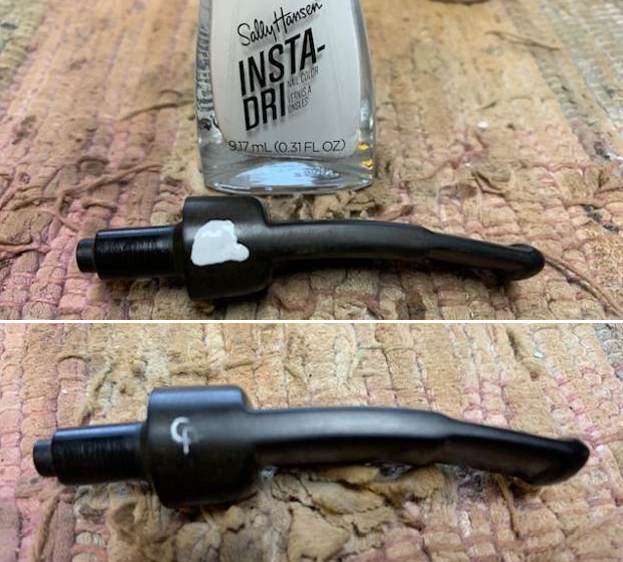 I polished the stem with micromesh sanding pads – 1500-12000 grit sanding pads and water to wet sand the stem. I wiped it down after each sanding pad with Obsidian Oil on a cotton rag after each sanding pads. I know that many say Obsidian Oil does nothing for acrylic stems, but I find it does two things – first it gives some protection to the stem from buildup and second it give the sanding pads bite in the polishing process.
I polished the stem with micromesh sanding pads – 1500-12000 grit sanding pads and water to wet sand the stem. I wiped it down after each sanding pad with Obsidian Oil on a cotton rag after each sanding pads. I know that many say Obsidian Oil does nothing for acrylic stems, but I find it does two things – first it gives some protection to the stem from buildup and second it give the sanding pads bite in the polishing process. 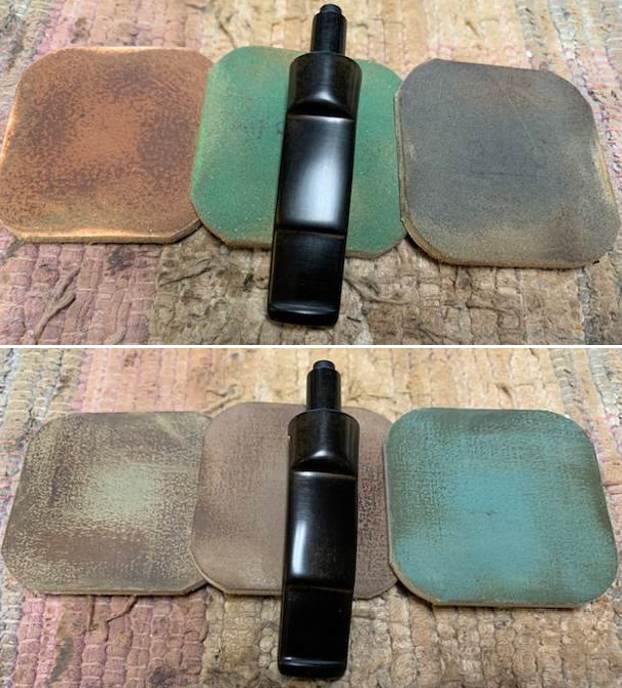
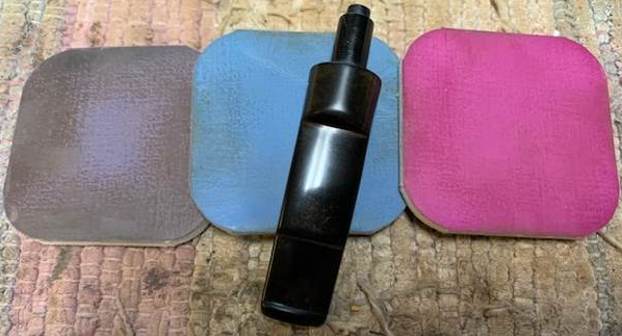 After finishing with the micromesh pads I rub the stem down with Before & After Fine and Extra Fine stem polish as it seems to really remove the fine scratches in the acrylic. I rub the Fine Polish on the stem and wipe it off with a paper towel and then repeat the process with the Extra Fine polish. I finish the polishing of the stem down with a final coat of Obsidian Oil and set the stem aside to let the oil absorb. This process gives the stem a shine and also a bit of protection.
After finishing with the micromesh pads I rub the stem down with Before & After Fine and Extra Fine stem polish as it seems to really remove the fine scratches in the acrylic. I rub the Fine Polish on the stem and wipe it off with a paper towel and then repeat the process with the Extra Fine polish. I finish the polishing of the stem down with a final coat of Obsidian Oil and set the stem aside to let the oil absorb. This process gives the stem a shine and also a bit of protection.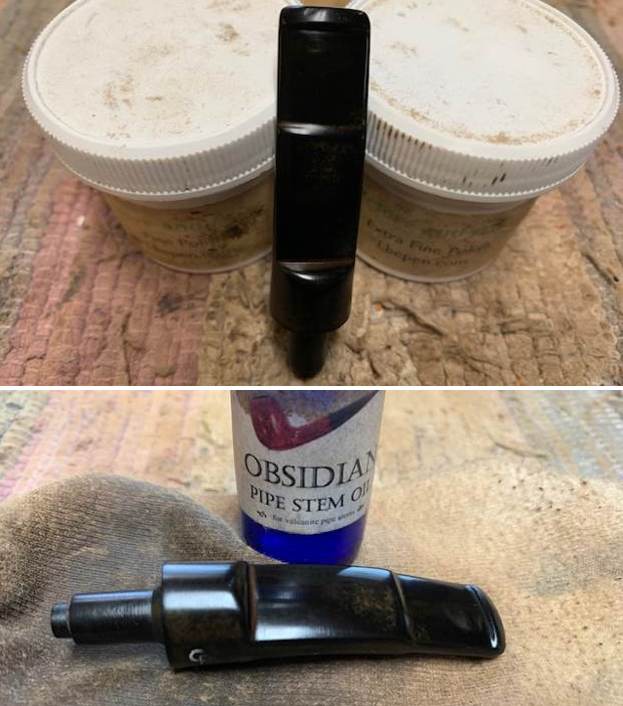 The final steps in my process involve using the buffer. I buffed the bowl and stem with Blue Diamond to polish out the light scratches in the briar and the vulcanite. I gave the bowl and the stem multiple coats of carnauba wax. I have found that I can get a deeper shine if I follow up the wax buff with a buff with a clean buffing pad. It works to raise the shine and then I hand buff with a microfiber cloth to deepen the shine. It is always fun for me to see what the polished bowl looks like with the polished stem. It really is a nice pipe. The smooth finish around the bowl sides and shank looks great. The vulcanite saddle DC stem works well with the pipe. The Charatan’s Make Special Made by Hand in City of London Billiard Sitter feels great in my hand. It is a well balanced pipe. Have a look at it with the photos below. The dimensions are Length: 6 inches, Height: 2 inches, Outside diameter of the bowl: 1 ½ inches, Chamber diameter: 1 inch. The weight of the pipe is 2.01 ounces/57 grams. It is a beautiful pipe that I will soon be adding to the rebornpipes store in the British Pipemakers Section. If you would like to add it to your collection let me know. It should be a great smoking pipe.
The final steps in my process involve using the buffer. I buffed the bowl and stem with Blue Diamond to polish out the light scratches in the briar and the vulcanite. I gave the bowl and the stem multiple coats of carnauba wax. I have found that I can get a deeper shine if I follow up the wax buff with a buff with a clean buffing pad. It works to raise the shine and then I hand buff with a microfiber cloth to deepen the shine. It is always fun for me to see what the polished bowl looks like with the polished stem. It really is a nice pipe. The smooth finish around the bowl sides and shank looks great. The vulcanite saddle DC stem works well with the pipe. The Charatan’s Make Special Made by Hand in City of London Billiard Sitter feels great in my hand. It is a well balanced pipe. Have a look at it with the photos below. The dimensions are Length: 6 inches, Height: 2 inches, Outside diameter of the bowl: 1 ½ inches, Chamber diameter: 1 inch. The weight of the pipe is 2.01 ounces/57 grams. It is a beautiful pipe that I will soon be adding to the rebornpipes store in the British Pipemakers Section. If you would like to add it to your collection let me know. It should be a great smoking pipe.
As always I encourage your questions and comments as you read the blog. Thanks to each of you who are reading this blog. Remember we are not pipe owners; we are pipe men and women who hold our pipes in trust until they pass on into the trust of those who follow us.